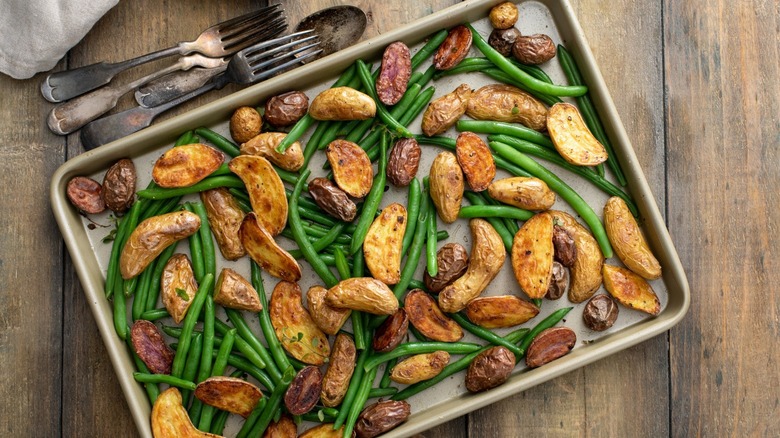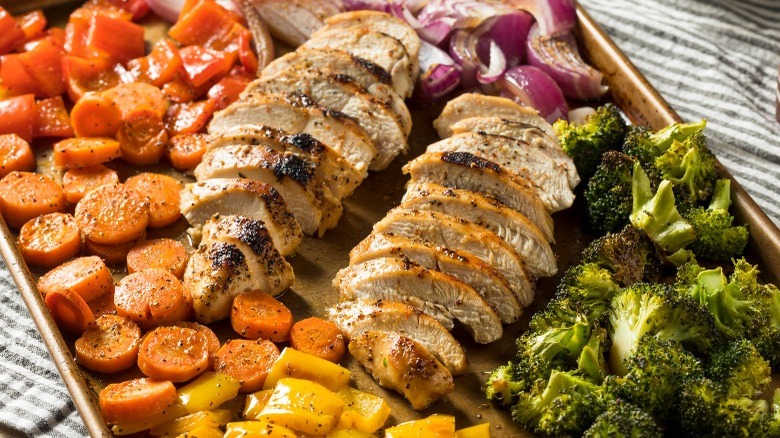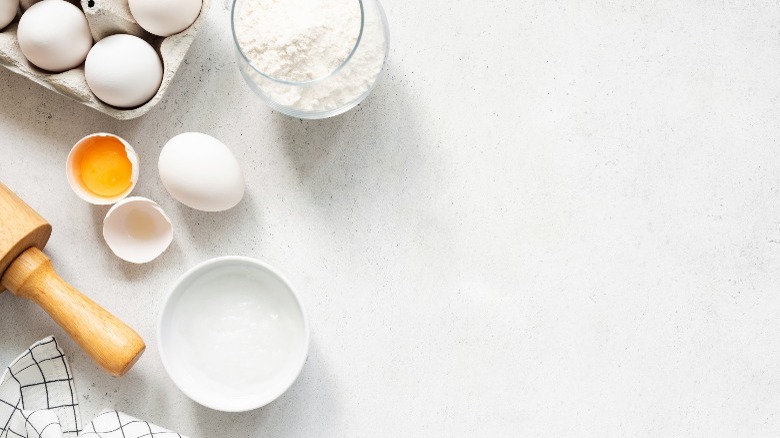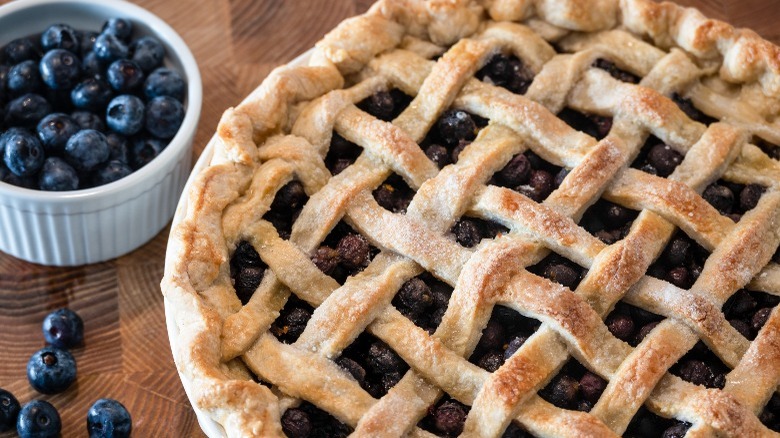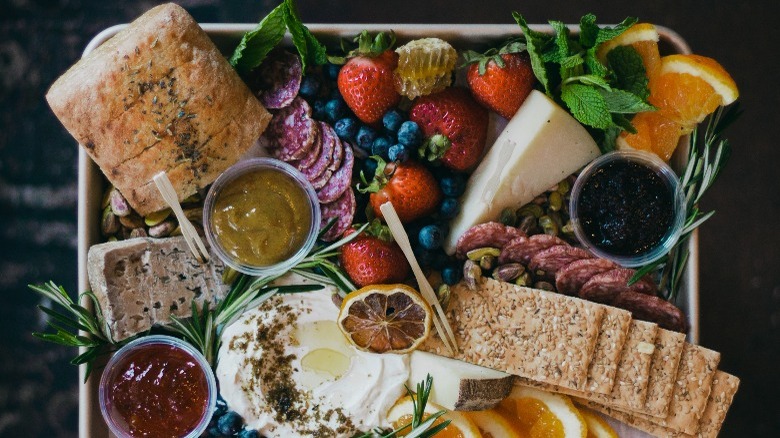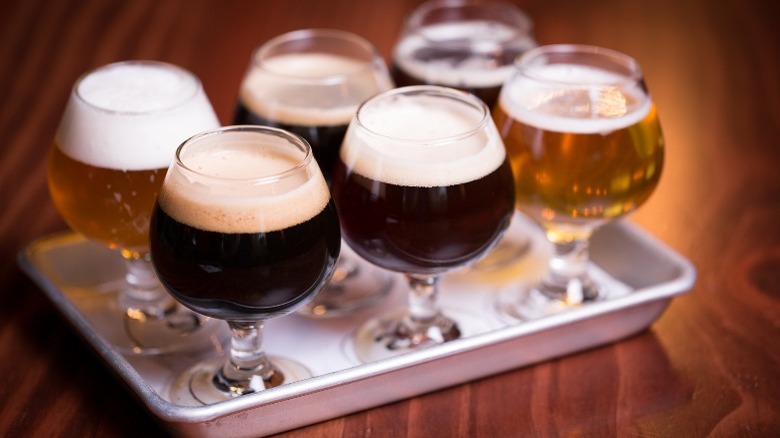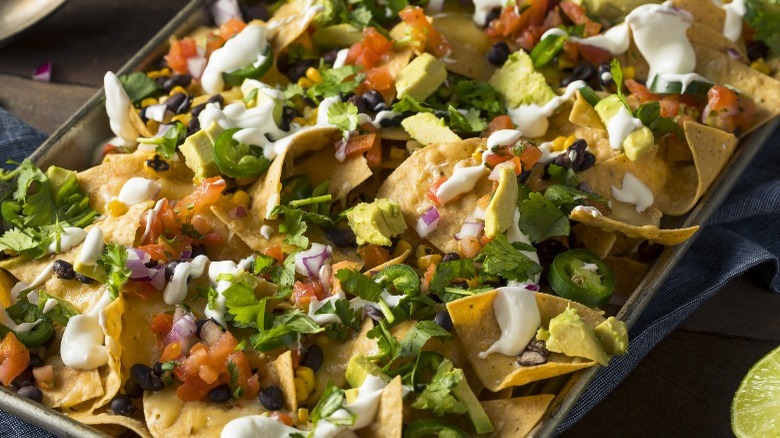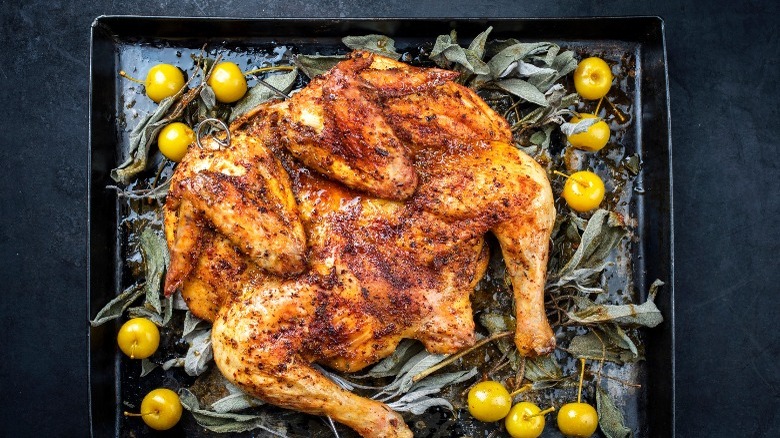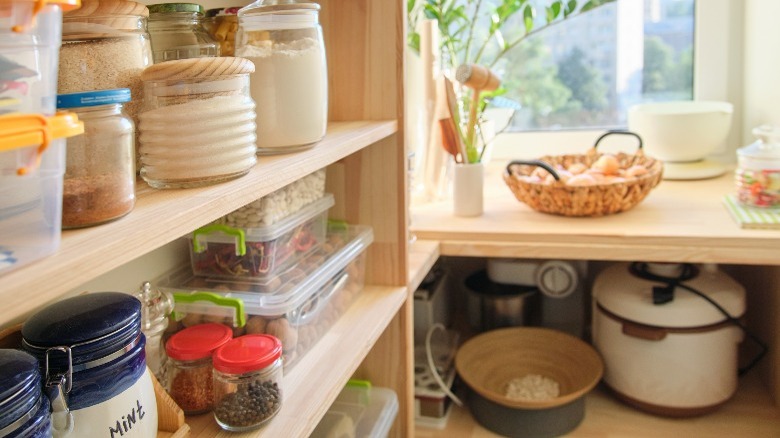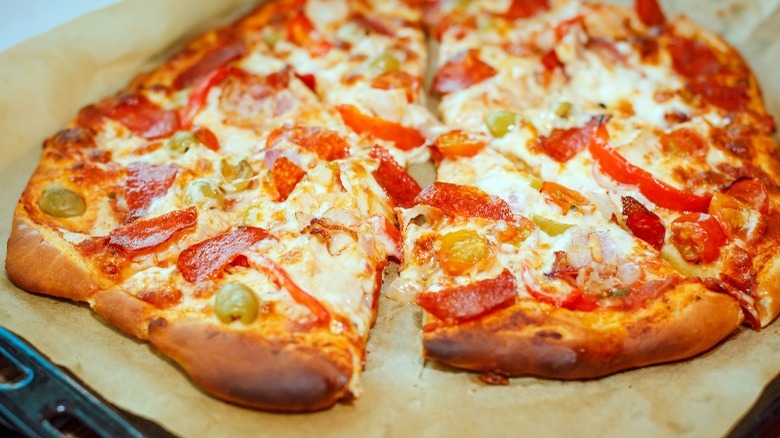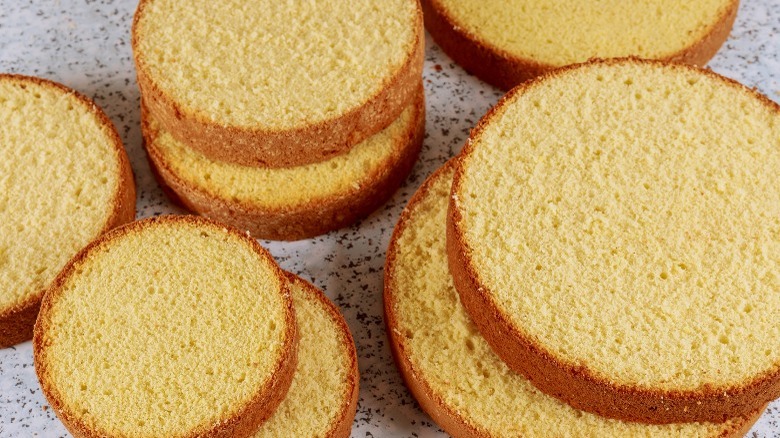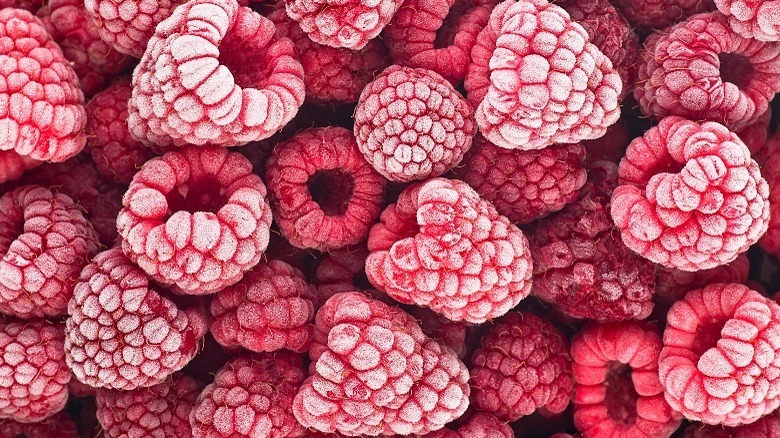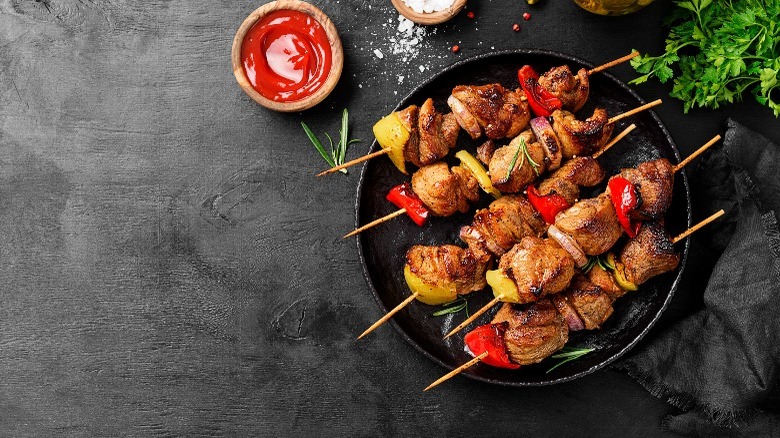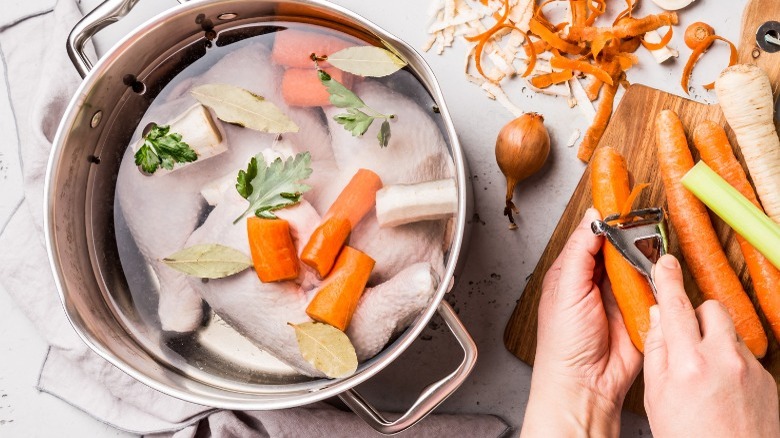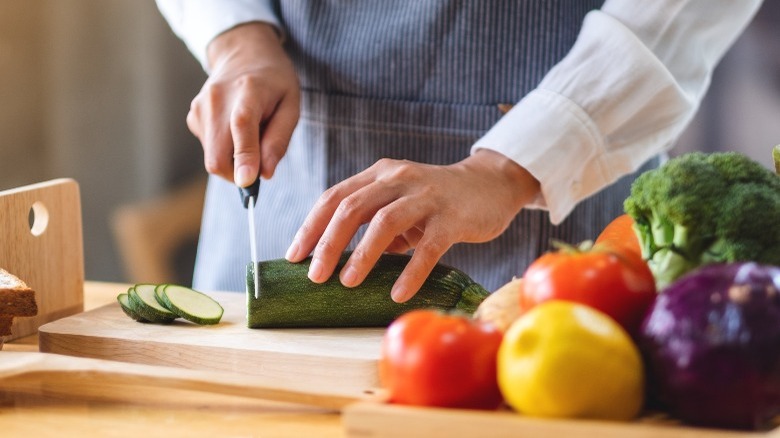The 14 Absolute Best Uses For Sheet Pans
The sheet pan might not be the most exciting or handsome piece of cookware in your kitchen — it's pretty plain jane at a glance. But when you think about how a regular old sheet pan can bring value to the heart of your home, you will never look at it quite the same.
Just in case you use the terms interchangeably (no worries, many people do), there is a real difference between sheet and baking pans. We're not talking about that aluminum square baking pan you use for brownies or even the deep rectangular Pyrex you use for casseroles all winter. We're bragging about that large, sturdy pan you use to bake cookies a few times a year.
The traditional sheet pan is rectangular shaped and shallow, with a raised rim and a large surface area. They come in a few notable sizes: the full sheet, which likely won't fit in your home oven; the half sheet; and the quarter sheet, which you probably have hidden somewhere in your cupboards.
You might already use it for roasting or baking breakfast bars, but boy, are you missing out on a few unconventional ways to make that pan shine. From making snack boards and setting tables to using them as a lid or freezer tray, the humble sheet pan has a way of being quite useful in and out of the kitchen.
Make quick and convenient family dinners
Sheet pan dinners are a saving grace on the nights when you don't feel like cooking. While it's a bit of a far stretch to say you won't have to lift a finger, it's essentially the most seamless way to bring a simple and delicious dinner to the table that your family will love.
Aside from a bit of chopping, drizzling, and sprinkling of spices, sheet pan dinners are as simple as dropping ingredients over a pan and placing the pan in the oven. The best part of these effortless dinners is that they look amazing and still technically honor the name homemade.
Whether a savory, full Irish breakfast is calling your name (umm yes, please), or a light and zesty chicken and roasted vegetables are more your style, reach for your sheet pan. It's the best way to bring the aroma of homemade glory into your kitchen in a small amount of time.
Plus, when you haven't gone to the grocery store but have a bunch of random ingredients hanging around, chop them up and create a signature meal. Who knows, you might achieve a new family favorite by the end of your meal.
Put together a mise en place tray
"Mise en place" is a French term believed to be coined by famous chef Georges-Auguste Escoffier, meaning "putting in place," per Michelin Guide. It is essentially the prep step that makes a good home chef and makes a world of difference from an organizational perspective. If you struggle with keeping your kitchen in order or constantly find yourself rushing around for ingredients while your food is burning in the background, mise en place is your answer.
Putting in place means premeasuring spices and having your protein and veggies prepped in advance. It means having every ingredient, appliance, and cooking tool within reach to ensure a seamless transition from one step to the next.
You can take your organization one step further by using a half-sheet pan as a tray to hold all premeasured ingredients. As you follow your recipe, you'll appreciate having everything set up in one place. Once you've worked through the recipe, consider using the sheet pan as a storage center for all your dirty dishes and cooking utensils.
Sheet pans will also come in handy if you prep your ingredients in the morning before cooking your meal later in the day. Feel free to seal your tray, place it in the fridge, and then grab it when you're ready to cook.
For transferring watery foods and catching juices
We have all fallen victim to a hot casserole or fruit pie that has bubbled over and into your oven. Not only do the burnt smells overpower what should be a dreamy aroma of homecooked goodness, but having to clean an oven is literally the worst. Luckily, with a tool as trusty as your sheet pan, you can minimize efforts and keep things tidy in the hot box.
First, let's talk pie. When you're making something like lemon blueberry pie or strawberry rhubarb pie, adding too much filling will undoubtedly spill over. The last thing you want is to ruin your perfect lattice with bubbly blue juices. All that hot liquid needs to go somewhere, and gravity always wins, so be sure to place your pies on a foil-lined sheet pan. Having the sheet pan to transfer the pie in and out of the oven will also help avoid breaking your pretty crust with thick oven mitts.
Very liquid desserts like French Canadian sugar pie and custards do better when transferred on a sheet pan too. It's one extra step to help avoid wobbly transfers and yucky spills. Baked sweet potatoes, on the other hand, love to excrete sweet juices thanks to high heat and fork holes. Those are stains you do not want to clean down the road, so be sure to line a sheet pan with foil and avoid placing your potatoes on the rack alone.
For making fancy charcuterie boards
A charcuterie board is the ultimate go-to party hors d'oeuvre that will elevate your food game. It's not a boring tray of veggies with generic veggie dip, and it's certainly not a plate of grapes and store-brand cheese. Charcuterie boards are meant to be stunning for your eyes and pleasing to the palate. It should burst with an array of unique cured meats, balanced with hard and soft cheeses and a few rustic bread assortments.
You can even add a few small mounds of nuts and pickles or provide a touch of complementing sweetness with tiny jars of tangy chutney or jam. While a wooden cutting board does wonders for aesthetics, not all of us have a decorative one on hand. Luckily, sheet pans can make an excellent base for your display. Whether you're building a spectacular arrangement to impress guests or your main goal is to feed many mouths, reach for your half sheet and start constructing.
Don't let old grease stains keep you from using your sheet pan for charcuterie — those spillover marks add character and will lend to your board's beauty. Add a sheet of brown parchment paper to your base if you can't get past the stains. The added layer and paper-beige hue will look lovely.
Use as a tray
A sheet pan is essentially a tray for holding foods that need to get hot, but it will shine outside of the oven too. If you have guests coming over and you need to set the perfect table for a dinner party before they arrive, your sheet pan will come in handy.
Gather your polished silverware, bread plates, linens, and drinking glasses, and set them up neatly over a sturdy sheet pan. From there, begin organizing your dinner table to fit your style. Using your sheet pan as a tray will help avoid back and forth while keeping a seamless production process.
The sheet pan will also come in clutch throughout the night as you set more food out for your guests to enjoy. Whether you push out bite-sized treats through the night or your homemade brew seems to be a hit, you'll love having a handy tray to help pass food and drinks out to guests. Putting out food also means picking up dirty plates and empty drinking glasses. So, as you notice plates piling up, grab that pan and get around to cleaning up.
Feed many mouths at once
Like sheet pan dinners, many recipes use the sheet pan as the primary cooking vessel for large appetizer batches. These starters are always a hit at Sunday football, board game nights with friends, or even birthday parties for the kids. Whether you need to make dozens of mini sheet pan sliders or a heaping pile of shredded chicken nachos, your sheet pan is the perfect base for your delicious creations.
Once all of your selected ingredients are prepped and ready, the job is quite effortless from there. Start with your base and layer up until you reach the top. Pop it in the oven, and you are minutes away from feeding a whole pack of hungry mouths.
We don't want you to think the sheet pan is only meant for the savory stuff. You'll love the idea of making large sheet pan desserts, too — the ultimate crowd-pleasing treat to end things right. Something like this delicious pumpkin chiffon pie will turn heads and keep everyone quiet toward the end of the night.
Make a fancy spatchcocked dinner
Thanks to spatchcocking, you can turn a whole chicken into a lovely roast with only a few bucks and a little homestyle butchering. It's challenging to achieve a juicy chicken or turkey roast because the breasts sit on top and receive direct heat, while the undersides do not. So undoubtedly, your breast will reach a safe internal temperature well before the thighs. If you wait for those thighs to reach 165 degrees F, you will end up with dry breasts.
To spatchcock, you must remove the backbone of a chicken or turkey using shears, open the bird, and roast it flat. Spatchcocking helps promote quick and even cooking and, in turn, creates succulent meat. When trying this out at home, you will appreciate having a sturdy sheet pan.
While all recipes vary, you can make a delicious sheet pan spatchcocked chicken (or turkey) with the help of some chopped-up mirepoix and fresh herbs. Scatter your aromatics over a sheet pan, place a wire rack over them, and lay your spatchcocked bird over the rack, skin side up. Follow our tutorial for more in-depth instructions on how to spatchcock a turkey or chicken.
Organize a deep pantry
Organizing your kitchen like a chef means eliminating physical steps and finding a good rhythm. It means storing your essential tools within reach and ensuring every serving utensil and piece of equipment have a home.
Mastering your organizational skills in the kitchen can take time as you learn your cooking style and understand what works best for you. Taking the time to organize your kitchen workflow now will help speed things up down the road.
Keeping things tidy can be more complicated when your kitchen space is limited or you find yourself stuck with an oddly shaped corner cabinet.
If you have one of those weird deep pantries or corner cabinets, your sheet pan will help tremendously. Save that section for kitchen tools or equipment you seldom use and place them on the sheet pan. The sheet pan can be used as a tray to remove and replace items as needed throughout the year.
Make sheet pan pizza
Who needs a pizza stone when you have a sheet pan to make pizza? Sure, it's not as hefty as a Chicago-style deep dish pizza or as saucy as a Sicilian pie, but we can, at the very least, call it dinner that everyone can enjoy.
You can make it as complex as crafting your dough, blitzing some canned tomatoes into a sauce, or go the ultra-simple route using all store-bought ingredients. Either way, sheet pan pizza is meant to feed more than a few mouths and fill bellies.
If you're already a big fan of sheet pan pizza and want to take your skills up a notch, consider making a Detroit-style pizza. It's usually stretched into a rectangular metal baking dish, but you'll get similar results using a quarter sheet pan as they measure the same.
The only downfall is the sides of a sheet pan don't come up as high as a baking pan, but you will still reach delicious results. Finish your pizza with a few slices of pepperoni or whatever you usually add on, and enjoy with a little dip of ranch dressing.
Cool down your hot cakes
There are many rules in the cake decorating world, and one you must embed into your brain is to cool cakes down before adding your frosting. When working in a cake shop, the production starts with baking the cakes and then cooling them completely. After they've cooled, they are typically placed in a freezer or fridge to chill.
Once they have reached cold temps, artists will use serrated knives to cut cakes into layers or carve them into various shapes, depending on what edible creation they plan to construct. Then it's crumb coats, frosting, and possibly a fondant layer.
In the competitive world of cake decorating, there isn't enough time to let those cakes cool off and chill. That's why, if you've watched "The Great British Baking Show," you may have noticed contestants anxiously waving sheet pans over their freshly baked cakes. The waving helps cool those cakes down in record time.
Believe it or not, this classic GBBO sheet pan trick really does work! So whether you're competing for a cash prize or you're competing with the clock before guests arrive for a party, feel free to try it out. You'd be surprised what a little arm workout and sheet pan waving can do.
Freeze fresh berries and herbs
There's nothing like taking advantage of fresh seasonal fruit and herbs. With an overabundance of all that delicious produce, though, you might find yourself with a little too much to handle. Luckily you can freeze summer fruits if you want to take advantage of all that delicious flavor (and all those excellent prices). Wash and air dry blueberries, raspberries, blackberries, and strawberries, then scatter them over a sheet pan. From there, let the ice box do all the work.
Once frozen, dump them into a large Ziploc bag. The sheet pan will help keep the berries separate when they begin to freeze so that you won't end up with one massive clump of frozen fruit. Fresh herbs with thick stems, like rosemary, thyme, and sage, can be frozen the same way.
You'll be glad you took the little time to freeze all that goodness in parts of the year when berries and fresh herbs are a little pricier. Your herbs will come in handy for soups, stews, and casseroles. Use berries for baked crumbles and pies, or throw a handful into a morning smoothie.
Soak your skewers during grill season
From cleaning your grill with an onion to knowing the difference between direct and indirect heat, there are plenty of grilling hacks you'll wish you knew sooner. There's one trick we want you to know about — and yes, your sheet pan comes into play here.
Making kebabs with dry skewers is one of the most common mistakes when grilling. We cut veggies and meat into the perfect bite-sized pieces, then marinate and thread them over skewers. All that work can turn into disappointment when you notice those sticks burn to a crisp.
Next time you make kebabs, do yourself a favor and soak the wooden skewers before grilling with them. Simply add the skewers to a sheet pan, then run some water over them until the entire surface of the sheet pan is covered and all skewers are submerged. Soak them for at least 10 to 20 minutes.
The sheet pan works great because it has enough of a large surface area for the longer skewers. The entire skewer must be submerged in water, and smaller baking dishes won't work if the stick doesn't fit within the pan.
Use as a lid
Funny enough, your sheet pan works wonders when you need a lid for a large saucepan, stock pot, or skillet. Whether you can't find that darn lid in your cabinets or just need a fitted top for your sizzling skillet, a sheet pan does the trick.
This is particularly helpful when steaming lobster in a large pot or making large soups or stews. Grab your half or quarter sheet pan, place it over the top, and watch as the steam disappears and stays within the cooking vessel.
You'll also love using it as a lid when making ramen for the family. If you plan on making a few individual bowls at a time, you can cut down waiting time with the help of a sheet pan. Make sure all of your bowls are close to one another. Place your ramen in each bowl, add the hot water, then place one sheet pan over every bowl to keep the heat in. From there, add your protein and a few other choice ingredients and slurp it up.
For catching veggies while chopping
If you love to cook, you already know that chopping veggies is part of the deal. You also understand that little flying pieces of carrots, onion, and celery come as a packaged deal every now and then.
This is especially true for beginners in the kitchen. If you're teaching your tween how to prepare meals, consider having them use a flat sheet pan underneath the cutting board as a way to help catch bits and pieces. For safety purposes, you can place a damp towel underneath the cutting board or sheet pan to ensure it stays in place.
Another handy trick that helps keep things tidy is using a sheet pan next time you plan on carving fresh corn kernels off the cob. Using a serrated knife, slice off the kernels and watch as your sheet pan catches all those juicy little morsels. You can even speed that process up with the help of an electric knife.
